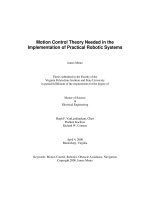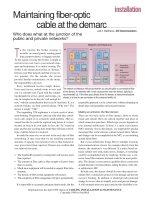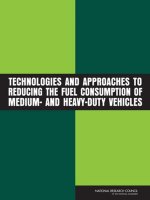Maintaining control over industry architecture the fuel retailing industry
Bạn đang xem bản rút gọn của tài liệu. Xem và tải ngay bản đầy đủ của tài liệu tại đây (1.85 MB, 217 trang )
MAINTAINING CONTROL OVER INDUSTRY ARCHITECTURE
THE FUEL RETAILING INDUSTRY
TAY KWONG KIAT
BSc (Hons), Mechanical Engineering, University of Strathclyde
MSc (MOT), National University of Singapore
C. Dip. A. F. - Certified Diploma in Accounting and Finance
C.Eng; FIMechE (UK)
P.Eng; Sr. MIES (Singapore)
A THESIS SUBMITTED
FOR THE DEGREE OF DOCTOR OF PHILOSOPHY
ENGINEERING & TECHNOLOGY MANAGEMENT
NATIONAL UNIVERSITY OF SINGAPORE
2014
ii
i
DECLARATION
I hereby declare that the thesis is my original work and it has been written by me
in its entirety. I have duly acknowledged all the sources of information which
have been used in the thesis.
This thesis has also not been submitted for any degree in any university previously.
Tay Kwong Kiat
07 August 2014
ii
ACKNOWLEDGEMENTS
I had to consult many colleagues, ex-colleagues, business partners, friends and
acquaintances in the fuel retailing sector as sources. I thank them for their help
even though I cannot identify their contributions as they have provided
information freely off the record.
I thank my supervisor, A/Professor Jeffrey Lee Funk for his suggestions, guidance
and direction during the course of my research. I am grateful for his support and
that of Dr Amit Jain and Professor Chihiro Watanabe.
Doing a PhD as a mature student was very challenging but I was inspired by
Professor CC Hang and A/Professor Marcelo Ang. I thank them for suggesting
this academic exercise as a way to enliven my mind from the humdrum of
working for many years in the same industry. I have met many professors and
classmates and they have knowingly or unknowingly motivated me on this
academic journey and so I thank them for their encouragement.
Finally, I thank my wife and my sons for their support during my research. My
eldest son, Wenkai, helped in editing the thesis.
iii
TABLE OF CONTENTS
DECLARATION i
ACKNOWLEDGEMENTS ii
TABLE OF CONTENTS iii
SUMMARY vii
LIST OF TABLES viii
LIST OF FIGURES ix
ABBREVIATIONS xi
LIST OF OIL COMPANY’S WEBSITES xii
1
INTRODUCTION 1
Industry background of the fuel retailing sector 4
1.1
Background of SE Asia’s fuel retailing sector 7
1.2
Objective of the research 10
1.3
Organization of the thesis 12
1.4
2
LITERATURE REVIEW 14
Fuel retail firm versus market 16
2.1
Vertical integration and asset specificity 18
2.2
Vertical integration and dealership agreement 21
2.3
Franchising model 22
2.4
Fuel retail station configurations 25
2.5
Industry Architecture of fuel retailing 27
2.6
Risk and uncertainty 30
2.7
Institutional environment and organization structure 34
2.8
Summary and theoretical gap 35
2.9
3
RESEARCH METHODOLOGY 38
Period covered 40
3.1
Leveraging on work experience 41
3.2
Leveraging on networking with professionals 45
3.3
Selecting cases 49
3.4
Information gathering 53
3.5
Analyzing data 57
3.6
iv
4
WITHIN-CASE ANALYSIS 60
Singapore 64
4.1
4.1.1 Background 64
4.1.2 Modernization/direct operations (S1) 67
4.1.3 Outsourced activities (S2) 72
4.1.4 Formed alliance/centralized supports (S3) 74
Indonesia 75
4.2
4.2.1 Background 76
4.2.2 Deregulation and market entry (I1) 80
4.2.3 Subsidy control/quality audit (I2) 82
4.2.4 Matched competitors by using direct operations (I3) 85
Malaysia 87
4.3
4.3.1 Background 87
4.3.2 Implemented self-service/ payment at pump (M1) 90
4.3.3 Sale of ExxonMobil network to Petron (M2) 93
4.3.4 Maintained model fuel retail station (M3) 95
Thailand 96
4.4
4.4.1 Background 96
4.4.2 Site staff organization (T1) 101
4.4.3 Introduced half-self service (T2) 102
4.4.4 Kept organization structure of acquired networks (T3) 103
Philippines 104
4.5
4.5.1 Background 104
4.5.2 Monitor remote stations using automation (P1) 109
4.5.3 Branded Marketer (P2) 111
4.5.4 Micro-filling stations (P3) 112
5
CROSS-CASE ANALYSIS 115
Types of oil companies 116
5.1
5.1.1 Major Oil Company (MOC) 117
5.1.2 National Oil Company (NOC) 122
5.1.3 Independent Oil Company 124
5.1.4 Composition of the types of oil companies across SE Asia 127
Organizational structures 132
5.2
5.2.1 Base organization structures 133
5.2.2 Variants to the base organization structures 136
v
5.2.3 Mix of organization structures in SE Asia 138
Industry Architecture of the fuel retailing sector 143
5.3
5.3.1 Centralized roles 144
5.3.2 Other roles 147
5.3.3 Managing the industry architecture 148
Impact of institutional environment 150
5.4
5.4.1 Biased regulations and standards 151
5.4.2 Shifting social norms 155
6
DISCUSSION 157
Risk management 159
6.1
6.1.1 Pattern from risk matrices 161
6.1.2 Dealing with risk 164
Managing risk leads to multiple level of industry architecture 167
6.2
6.2.1 The base organization structure and types of oil companies 168
6.2.2 Role of the oil companies as guarantors of quality 170
6.2.3 Modifying organization structure to manage risk 171
6.2.4 Concluding remarks 174
Contributions and limitations 175
6.3
6.3.1 Contributions 175
6.3.2 Limitations 177
6.3.3 Alternative explanations 178
6.3.4 Efficiency reason 179
6.3.5 Gains from specialization 180
Implication of research findings 181
6.4
7
CONCLUSION 183
REFERENCES 187
APPENDIX A 199
vi
vii
SUMMARY
The industry architecture of the fuel retailing sector in SE Asia varies both within
and across countries, with roles distributed among the oil companies and other
players. These variations, or multiple levels of industry architecture, represent the
vertical disintegration of the sector to different degrees. Although the regulatory,
technological, infrastructure and social constraints of the different countries may
force oil companies to use different industry architecture, these constraints alone
cannot explain why even a single oil company would operate with multiple levels
of industry architecture within a country. The existing literature, which models the
sector simplistically as a dyadic relationship between the oil company and their
dealers, does not adequately explain this phenomenon. My This research suggests
that the emergence of multiple levels of industry architecture in SE Asia is a result
of oil companies using different organization structure depending on different
institutional environments to manage the risk of operating in this sector. The study
shows that oil companies manage risk by distributing roles within the sector to
strike a balance between reducing exposure to risk under respective institutional
environments and minimizing the impact should an adverse event occur. It is this
balancing act of oil companies varying organization structure to manage risk, even
within the same network, that led to the multiple levels of industry architecture in
this sector.
viii
LIST OF TABLES
Table 1 Work activities in oil industry 42
Table 2 Case study countries with key oil companies 51
Table 3 Interviewees 56
Table 4 Stations by type of operations in Singapore 64
Table 5 Risk management – Singapore 72
Table 6 Stations by type of operations in Indonesia 76
Table 7 Risk management - Indonesia 83
Table 8 Stations by type of operations in Malaysia 87
Table 9 Risk management – Malaysia 94
Table 10 Stations by type of operations in Thailand 99
Table 11 Risk Management – Thailand 104
Table 12 Stations by type of operations in Philippines 107
Table 13 Risk management – Philippines 112
Table 14 Classification of oil companies 118
Table 15 Characteristics of oil companies 131
ix
LIST OF FIGURES
Figure 1 Oil industry value chain 4
Figure 2 Shell's fuel retail stations in SE Asia 7
Figure 3 Risk Matrix - Example 61
Figure 4 Singapore vehicle and station population 66
Figure 5 Risk Matrix – Singapore 68
Figure 6 Typical MOC retail organization (small COCO & CODO network) 71
Figure 7 Indonesia vehicle and station population 77
Figure 8 Risk Matrix – Indonesia 78
Figure 9 Pertamina's COCO network 86
Figure 10 Malaysia vehicle and station population 88
Figure 11 Risk matrix – Malaysia 91
Figure 12 Thailand vehicle and station population 97
Figure 13 Risk matrix – Thailand 103
Figure 14 Philippines vehicle and station population 106
Figure 15 Risk matrix – Philippines 113
Figure 16 MFS and standard fuel retail station 114
Figure 17 Proportion of stations by types of oil companies 127
Figure 18 Number of oil players from 1990 to 2012 128
Figure 19 Base organization structures 135
Figure 20 Variants of base organization structures 137
Figure 21 Proportion of stations under COCO, CODO and DODO 139
Figure 22 Organization structure by country 140
Figure 23 Shell’s organization structure by country 141
Figure 24 Chevron’s organization structure by country 142
x
Figure 25 Models of industry architecture 149
Figure 26 Risk matrix of cases 163
Figure 27 Typical approach in risk management 165
Figure 28 Risk management - modifying industry architecture 166
xi
ABBREVIATIONS
ATEX Appareils destinés à être utilisés en
AT
mosphères
EX
plosives
Auto-LPG Auto Liquefied Petroleum Gas
BP British Petroleum
BP MIGAS Badan Pelaksana Kegiatan Usaha Hulu Minyak dan Gas Bumi
BPH MIGAS
Badan Pengatur Hilir Minyak dan Gas Bumi
C
-
Store
Convenience Store
CNG Compressed Natural Gas
COCO Company–Owned, Company-Operated
CODO Company–Owned, Dealer-Operated
COE Centre of Excellence
COF Centre of Focus
DODO
Dealer
–
Owned
,
Dealer
-
Operated
EMV
Europay, MasterCard and Visa
HSSE Health, Safety, Security and Environment
IPPCA Independent Philippine Petroleum Companies Association
LPG Liquefied Petroleum Gas
MID Measuring Instruments Directive
MOC Major Oil Companies
MOPS
Mean of Platts Singapore
NACS
The Association for Convenience and Fuel Retailing
NOC National Oil Companies
NPPA New Petroleum Players Association Of The Philippines
OIML International Organization of Legal Metrology
PDB Petronas Dagangan Sdn Bhd
PTT
Petroleum AuThority of Thailand
RON
Research Octane Number
SCDF Singapore Civil Defence Force
SE Asia Southeast Asia
SMC San Miguel Corporation
SPC Singapore Petroleum Corporation
UL Underwriter’s Laboratory
xii
LIST OF OIL COMPANY’S WEBSITES
Bangchak www.bangchak.co.th/en/index.aspx
BHPetrol www.bhpetrol.com.my/
Chevron Malaysia www.chevron.com/countries/malaysia/
Chevron Philippines www.chevron.com/countries/philippines/
Chevron Singapore
www.chevron.com/countries/Singapore/
Chev
ron Thailand
www.chevronthailand.com/
ExxonMobil Singapore www.exxonmobil.com.sg/AP-English/default.aspx
Esso Thailand www.esso.co.th/Thailand-English/PA/default.aspx
Flying V www.flyingv.com.ph/
Paktai Oil www.ptgenergy.co.th/home/index/EN
Pen Petroleum www.penpetroleum.com.my/
Perry’s fuel
/>-
us/
Petronas
Dagangan
www.mymesra.com.my/
Pertamina www.pertamina.com/en/
Pertamina Retail
Petron www.petron.com/web/
Petron Malaysia www.petron.com.my/web/
Phoenix Petroleum
PTT
www.pttplc.com/en/pages/home.aspx
PTT Philippines
www.pttphils.com/
PTT-RM www.pttrm.com/front/Home/Index.aspx
Pure Thai Energy www.pumppure.com/html-th/home/index.php
Seaoil Philippines www.seaoil.com.ph/
Shell Indonesia www.shell.co.id/en.html
Shell Malaysia
www.shell.com.my/
Shell Philippines
/>
Shell Singapore www.shell.com.sg/
Shell Thailand www.shell.co.th/en.html
SPC www.spc.com.sg/home/home.asp
SUSCO www.susco.co.th/
Total Oil Indonesia www.id.total.com/en/home.html
Total Oil Philippines
www.totaloil.com.ph/home.html
1
1
INTRODUCTION
This research argues that the multiple levels of industry architecture in Southeast
Asia (SE Asia) reflects the different approaches that oil companies use to deal
with the risks of operating in this sector. The fuel retailing sector is the part of the
oil industry’s fuel distribution infrastructure. The sector serves the motoring
public through the ubiquitous fuel retail station which is known by many names
such as fuelling station, filling station, gas station, petrol station, service station
and retail outlet. The multiple levels of industry architecture are the various
combinations of independent economic players and relationships between these
players coexisting within a sector and thus the multiple levels represent varying
degree of vertical disintegration. From empirical evidence gathered from
interviews with professionals in the sector, this research suggests that the varying
degree of vertical disintegration is the result of efforts by oil companies modifying
the industry architecture to manage risk and uncertainty, that is, by lowering the
probability of risk as well as reducing the impact from risk events.
Fuel retailing appears to be a simple task of selling the finished products of
refineries mainly gasoline and diesel for motor vehicles. The fuel retailing sector
consists of networks of multiple and seemingly identical fuel retail stations spread
across a wide area with each network managed from a central location. This
service sector is assumed to be relatively straightforward to organize as compared
to the industrial sectors. In the academic literature, the organization structure of
the fuel retailing sector is modelled with two economic players. One player is the
oil company supplying the fuels to a network of fuel retail stations. The other
2
player is the set of dealers or station managers deployed for the network, with
each dealer or station manager managing a fuel retail station. The typical
organization structures from the combination of these two economic players are:
(1)
oil company operating its fuel retail stations directly with its own
employees
(2)
oil company operating its fuel retail stations through dealers
(3)
independent dealer operating dealer-owned fuel retail stations
In reality, the fuel retailing sector has evolved to be increasingly complex and
there are many more economic players than just the oil companies and the dealers
participating in the sector. With rising oil prices, the margin from selling fuels is
often not enough to offset the fixed operating costs of the fuel retail station. The
income for the operator has to be supplemented with earnings from having a
convenience store, lubrication bay or car wash within the fuel retail station, but
these businesses also bring in new players into the sector. The increasing use of
technology allows many manual tasks to be simplified and automated. These
automated systems bring in players that can carry out these tasks remotely and
allow help-desk and support functions to be outsourced and fuel inventory and
fuel leak alarms to be centrally monitored. Changing consumer habits also allow
for new and faster ways to pay at the pump. The adoption of the fully unattended
self-service model brings in payment specialists and eliminates the needs for
pump attendants and cashiers. There are also increasing requirements to comply
with regulations, especially those to meet global environmental standards.
3
Environmental specialists are roped in to monitor fuel retail stations regularly to
ensure compliance with these standards.
To address these evolutionary changes to the fuel retailing sector, oil companies
modify the organization structures to introduce the new players into the sector,
divide tasks among players and realign the relationships between players.
Therefore, the academic model of the organization structure based on the two
economic players, the oil company and the dealer, is inadequate for this research
that seeks to understand why the fuel retailing sector has multiple levels of
industry architecture involving multiple players. The basic academic model can
only be the starting point for analysing the fuel retailing sector. It has to be
extended to include the additional roles and other players in the sector.
To understand a sector that has evolved with new economic players inserted into
the value chain, Jacobides suggests an inductive analysis of a sector that allows
new analytical insights on how vertical disintegration emerges (Jacobides, 2005).
He claims that the study of industry architecture, that is, the “way to divide and
organize labour in each sector” (Jacobides, 2008, p. 259), shows us “how some
companies manage industry architectures to their advantage” (Jacobides, 2009, p.
71). He suggests studying the “different ways in which roles are distributed
among a set of interacting firms” (Jacobides, Knudsen, & Augier, 2006, p. 10).
Analysis based on this approach is a practical way of looking at the nature of an
industry as opposed to the “generalist preoccupation with macro-trends”
(Jacobides, 2008, p. 268). This research scrutinizes the various roles in the fuel
retailing sector to uncover the underlying reasons why roles are added, broken up
4
Figure 1 Oil industry value chain
and eliminated by the oil companies and how this changes have resulted in the
multiple levels of industry architecture of the sector.
Industry background of the fuel retailing sector
1.1
The oil industry is one of the biggest industries in the world and is usually
described to consist of the four vertically integrated processes, namely exploration,
production, refining and distribution. The vertical integration of oil industry
means that the same oil company is involved in these four processes: searching for
crude oil; extracting the crude oil from the ground; shipping this crude oil to
refineries to be processed into useful naphtha, kerosene, diesel, gasoline and fuel
oil; and distributing these petroleum products to customers.
The petroleum products are delivered in bulk as feed stocks to petrochemical
industries, power stations and factories or delivered to large storage tanks in ports
5
and airports that supply the fuels for ships and airplanes. A not too insignificant
amount of gasoline and diesel is dispatched by barges, pipes and tank trucks
1
into
storage tanks, mostly underground tanks, deployed in designated locations around
the countries. These locations are either the commercial fuel outlets or the fuel
retail stations. The gasoline and diesel are delivered to commercial outlets that are
usually owned by companies that have to provide the fuels for their own fleet of
buses, taxis and trucks. The gasoline and diesel delivered to the fuel retail stations
are sold to the motoring public. This last segment of the value chain that brings
the fuels from terminal to fuel retail stations to be sold to the motoring public is
the fuel retailing sector and is the subject of this research (Figure 1).
As the oil industry evolved and grew in complexity, the oil companies subdivided
the activities of the oil industry into smaller but sizeable chunks (Frankel, 1953)
so that these can be easily managed internally by the oil companies. Many of these
activities, individually insignificant in comparison to the whole value chain
(Figure 1), have since been taken over by specialized players and the industry is
no longer as vertically integrated as in the past. This is also the case for the fuel
retailing sector which has a complex sub-division of activities that are usually not
described and incorrectly lumped together as oil companies’ integrated activities.
The fuel retailing sector consists of fuel terminals or depots and the fuel retail
stations spread across the country. There are at least half a million fuel retail
stations in the world. Each fuel retail station has an expensive underground fuel
1
Tank trucks, also known as tankers, tanker trucks and bowsers, are motor vehicles specially
designed to carry fuels from the terminal to the fuel retail station.
6
system stuck at a dedicated location. The fuel system consists of buried steel tanks,
pipes and pumps connected to fuel dispensers. The fuel dispensers are the units
commonly referred by customers as “pumps”. A set of specialized controls and
automated monitoring systems ensure that all these components work efficiently
and safely for the “pumps” to deliver the correct amount of fuel to the customer’s
vehicle. The whole system is also engineered to ensure that the fuels do not leak to
the ground or into the atmosphere. On a regular basis, either by a request initiated
by the dealer of a fuel retail station or an automatically triggered instruction from
a central planning centre, the nearby fuel terminal or depot will be alerted to
dispatch tankers to replenish the tanks at the fuel retail stations. The location of
each fuel retail station is selected for the convenience of customers but the
location in some countries may be specifically approved exclusively for the
retailing of fuels. Once the fuel retail station is built on it, the location will likely
remain as a fuel retail station for the next thirty years or more.
It is usually the oil companies that owned the land and built these fuel retail
stations to their own exact specifications. With these specialized assets installed
permanently in a fixed location for extended periods and without alternative use,
the organization structure for the fuel retailing sector would be vertically
integrated, that is, with all the specialized assets owned and value-adding
activities done within the oil company. However, the reality is that the fuel
retailing sector in SE Asia has varying degrees of vertical disintegration ranging
from one extreme with all the activities done within the oil company to the other
extreme where almost all of the activities are undertaken by different firms.
7
Figure 2 Shell's fuel retail stations in SE Asia
Source: Shell’s online station locator (www.shell.com)
Another characteristic of the fuel retailing sector that shaped its organization
structure is the way fuel retail stations are deployed. Fuel retail stations are useful
to customers only when these are well spread out across a country. However, a
network of thousands of fuel retail stations branded by one oil company and
deployed across an archipelago like the Philippines can be difficult to manage.
Figure 2 shows the extent of the deployment of Shell’s 2,650 fuel retail stations
across SE Asia. Each number shown in each box indicates the number of fuel
retail stations around a location, typically a city. This spread of fuel retail stations
across a country is also the typical deployment for the other oil companies. It is
therefore not hard to imagine the complexity of organizing the industry
architecture for such a widespread network of fuel retail stations.
Background of SE Asia’s fuel retailing sector
1.2
8
The organization structure of the fuel retail sector in SE Asia was originally put in
place by foreign oil companies and subsequently adapted by national and
independent oil companies in response to the regulations and standards,
technology and social norms of each country.
When the fuel retailing business in SE Asia was started by the major oil
companies and their predecessors, they could not deploy their existing
organizational arrangements over to SE Asia and had to seek different ways to
operate networks of fuel retail stations in each country. Since then, these
executives of Shell, Stanvac
2
and Caltex that set up the network of stations in
many of the SE Asian countries have been replaced by new breed of executives
and thus the industry architectures of this sector have evolved to be very different
from their predecessors and each other.
By 1990’s, national oil companies such as Petronas and PTT that started their
networks much later than the major oil companies began to establish new ways to
organize the fuel retail business as they gained leadership position. Independent
oil companies, freed by deregulation to participate in the fuel retail sector, also
extended the organization structures based on the niche areas from which they
originated in order to compete with the other players. The fuel retail sector in SE
Asia was also transformed during this period through the rebuilding the fuel retail
stations with standardized design incorporating features to enhance safety and
environmental protection, the use of sophisticated electronic-based equipment so
that these can be automated and the streamlining of operating procedures such as
2
Stanvac was the joint venture of Socony-Vacuum (Mobil) and Jersey Standard (Esso).
9
introducing self-service and card payment to increase the throughput of each
station. This modernization of the fuel retail sector resulted in a change to the
industry architecture in that many new players were introduced into the sector.
However, with the eleven countries in SE Asia at different stages of economic
development and governed under very different political regimes, some countries
do not progress fast enough to have the physical and technological infrastructure
to support this modern way of operating a fuel retail network. Countries made up
of many islands such as Indonesia and Philippines were limited by the
telecommunication and road or rail infrastructure to support efficient delivery of
fuels to the fuel retail stations spread across the country. Thus the heterogeneous
characteristics of the countries in SE Asia were factors for the different forms of
organization structure that were put in place for the fuel retail sector.
There was more than one form of organization structure in use in each country. In
Singapore, the network was operated directly and with the fuel retail stations
owned by the oil companies. In Indonesia, the fuel retail stations were
predominantly owned and operated by dealers. In the other countries such as
Philippines, Malaysia and Thailand, there were a mix of these two types of
organization structure as well as one other type that has the fuel retail stations
owned by the oil company but operated by an independent dealer appointed by the
oil company.
The different mix in each country was not because each oil company was
employing its choice of organization structure to meet the constraints of the
10
country’s institutional environment. In fact, each oil company implemented more
than one organizational structure in each country. At the superficial level, the
same type of organizational structure may appear to be similar across different
countries. A more detailed examination of the contractual arrangement for the
same type of organization structure shows that there were differences, say,
between the direct operation used in Thailand and that used in Singapore. These
differences were present even for the same oil company operating across the
different countries of SE Asia. For example, ExxonMobil contracted with an
individual manager to manage each fuel retail station directly in Singapore. In
Thailand, ExxonMobil set up a separate business entity, Thai C-Centre, to operate
the company-owned fuel retail station directly.
The operations of some of the fuel retail networks in SE Asia grew increasing
complex as the business evolved to include convenience store, self-service
operation and card payment. These additional activities could no longer be
managed by in-house by the oil companies. Instead, specialists in these areas of
business were roped in to take up these roles.
Objective of the research
1.3
The fuel retail sector has existed for more than 100 years, yet there was limited
research to understand how it was organized and how the organizational structure
has evolved. Some researchers claimed that this was due to lack of data or detailed
description of the organization structure for qualitative or quantitative analysis
because the oil companies were very protective of their information. The literature
11
review also shows why the existing academic literature, based on the
characteristics and constraints in North America cannot be used to explain the fuel
retail sector in SE Asia that has evolved to include multiple players within the
sector. One reason for the inadequacy of existing theories is that these studies on
organizational structure were based on a model with two economic players. The
other reason is that there was no attempt to explore the effect of risk management
on organization structure of the fuel retail sector.
Based on the background on the fuel retail sector in SE Asia and the inadequacy
of academic literature to explain the organization structure that has evolved with
multiple players, the research question raised is “Why are there multiple levels of
industry architecture of the fuel retail sector in SE Asia?” The multiple levels of
the industry architecture represent the vertical disintegration of the sector to
different degrees.
The aim of the research is to uncover the underlying cause that has led to the
varying degree of vertical disintegration of the fuel retail sector in five countries
in SE Asia. To answer this, the research collected the data from five countries in
SE Asia including the background on how the organization structure was put in
place and the changes made to the organization structure during the period 2000 to
2013 as the fuel retail sector evolved.
As this study looked at five countries with different political, cultural, social and
economic characteristics, the analysis took into account the impact of the different
institutional environments on the organizational structure. The analysis also









